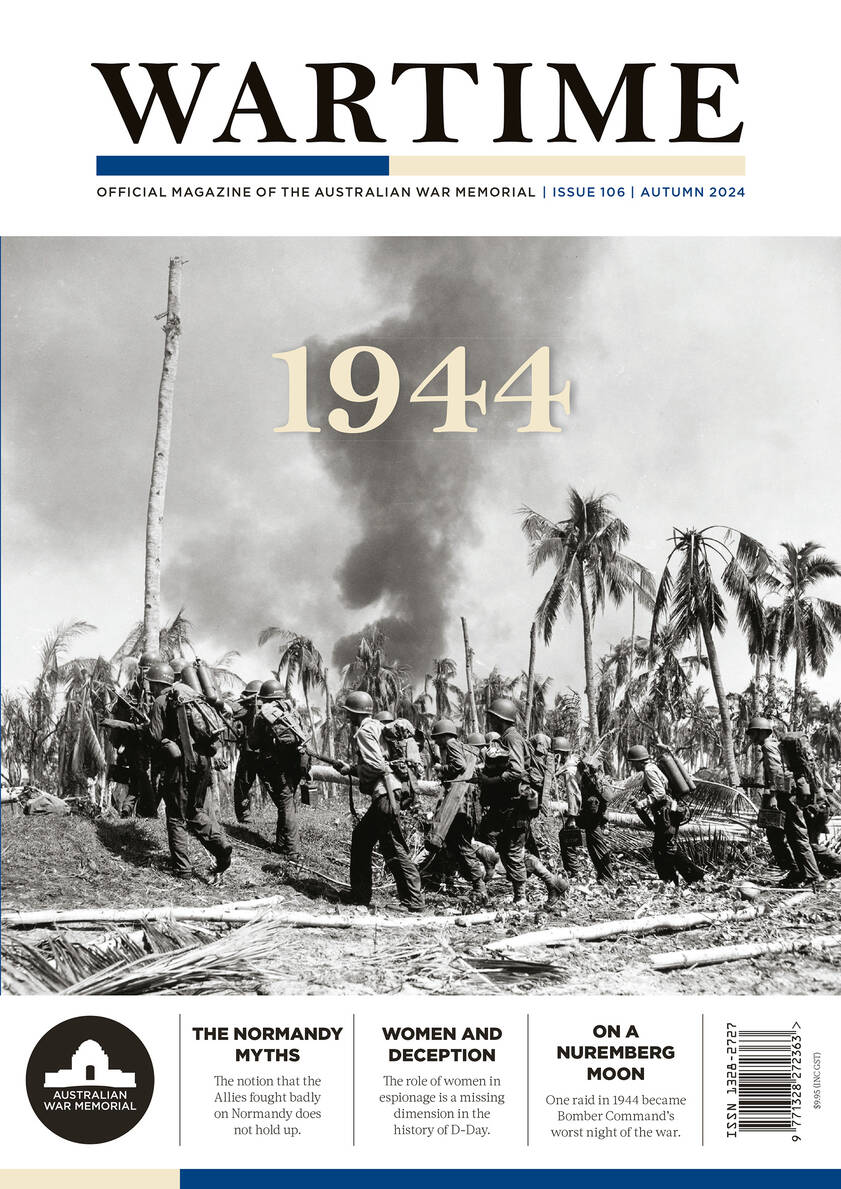The Tribal Class destroyer served widely and with distinction in waters to Australia’s north in 1944.
A Navy object of quiet significance sits among the tanks, artillery and aircraft at the Mitchell Annex of the Australian War Memorial: an imposing, dark gun turret with hints of bright steel, once covered by grey paint. This gun mount is one of the few remaining items that witnessed a significant Australian Navy contribution to the latter stages of the Pacific campaign in the Second World War. It came during the push northward against the Japanese invasion, providing cover at sea to troop and supply convoys, and bombardment of the enemy ashore before landings.
The twin 4.7 inch (120mm) barrels of the quick-firing guns point slightly downwards now, and the view from behind reveals the complex inner workings of the loading and firing system of Y turret, which saw distinguished service while fitted to the aft-most gun position of the Royal Australian Navy Tribal Class Destroyer, HMAS Arunta (I).
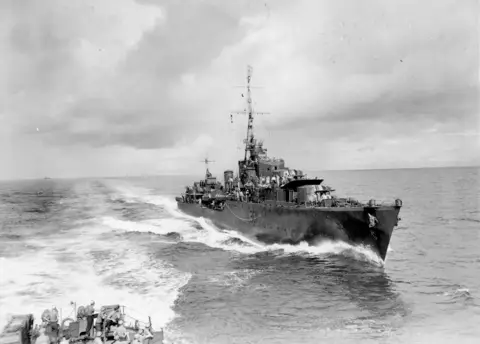
HMAS Arunta, 30 July 1943. Courtesy of Sea Power Centre.
HMAS Arunta (pennant number I30, then D5, and later D130) was the first of the three Tribal Class Destroyers to serve in the Royal Australian Navy (RAN). It was built at Cockatoo Island dockyard in Sydney, launched on 30 November 1940 and commissioned in 1942.
These compact but powerful vessels were built to a proven design developed and operated by the Royal Navy; their local production is a key demonstration of the rapid increase in shipbuilding capability undertaken by Australia, which delivered not only three destroyers, but sixty corvettes and a myriad of smaller ships and watercraft in just a few years.
Britain was stretched beyond capacity in the attempt to provide Navy support to the dominions and colonies while prosecuting a war of two theatres across the globe. Most of the small RAN fleet was already deployed to the European theatre, leaving Australian maritime approaches with minimal defence against the advancing Japanese forces.
After the fall of France, Britain and the Allies undertook defensive seapower operations in an attempt to keep vital sea lines of communication open around the world to support trade and the war effort. It took time and concerted effort to rebuild capacity in the Allied maritime forces to develop the required offensive striking power to push the enemy back in both main theatres of war. The Australian construction and operation of the Tribal Class destroyers was a small example of this success, but one that delivered an outsized positive result. Before the Second World War there was one major active shipyard in Australia, but by 1942 an incredible tally of two ships per month was being turned out of seven major dockyards under an innovative decentralised production model.
A total of 27 Tribal Class ships were built for the navies of Britain, Australia and Canada. They were generally outfitted with British weapons, sensors and auxiliary equipment; some had local modifications, either as a result of lessons learned in theatre, or because of supply issues. At 115 metres in length and with a draft of 2.74 metres, the vessels were capable of a top speed of 36 knots. The Australian variant was armed with a formidable array of three 4.7 inch rapid-fire guns, one four-inch anti-air gun, plus six 40mm anti-aircraft guns and four two-pounder anti-aircraft guns. The vessels were also fitted with four 21-inch torpedo tubes, and a number of anti-submarine depth charge launchers, both of which were utilised to sink or cripple a number of Japanese ships and submarines.
Designed for fleet operations, convoy escort, patrol, shore bombardment and amphibious landing support, Arunta and the other vessels of her class demonstrated their serviceability on many occasions. They became an integral part of the push north through the Pacific island chain, contributing to almost every Allied landing operation. The Tribal Class destroyers follow the original Royal Navy naming custom of each vessel being named after a tribe of Indigenous peoples, with HMAS Arunta being named for the Arrernte people of Central Australia. Each ship develops its identity and personality, and Arunta was no different, with the crew identified colloquially as ‘Tribal Natives’ and ‘destroyer men’. But this means that individual tales from the crew are hard to find: Navy stories are aggregated to be stories of the ship, and the human stories can be lost.

HMAS Arunta added its firepower to major naval bombardment of Cape Gloucester before Unites States Marines went ashore in December 1943. Photographer unknown.
On station
Soon after commissioning in May of 1942, Arunta joined the war effort, undertaking anti-submarine patrols on the Australian Station, then later in the broader Pacific area. The capability of the vessel was soon demonstrated when it sank a Japanese submarine (RO-33) on 29 August off the coast of Papua near Port Moresby. From August Arunta began escort duties for general shipping to protect the flow of goods in and out of Australia, and for convoys in support of troops and supplies between Australia and Papua.
After evacuating Lancer Force guerillas and civilians from Timor in early 1943, Arunta was assigned to Task Force 74, a combined US–Australian force within the US 7th Fleet. The Australia Squadron was under the command of Commodore John Collins and comprised Arunta, fellow Tribal Class destroyer Warramunga and the cruisers Shropshire and Australia, the Australian flag ship. The squadron would render nearly continual service to this and other Allied task groups in support of United States and Australian troop landings throughout the South-West Pacific Area from May 1943, until the ship sailed for Sydney to undergo a major refit in July 1945.
The 1943 patrols were relatively uneventful, although Arunta and Warramunga participated in some significant shore bombardments against Japanese ammunition dumps, and various escort duties for transports Westralia, Manoora and Kanimbla. Towards the end of 1943, Task Force 74 was strengthened with the addition of several US ships (USS Ralph Talbot, Helm and later Phoenix) in preparation for New Britain operations, which were to be the precursor to the push into the Philippines and then further north by US Allied forces. The initial phases of the New Britain operations were mainly unopposed, with only minimal Japanese air counter-attacks against later landings at Cape Gloucester.
HMAS Arunta at Cape Gloucester
Units of the Australian and American navies take part in the pre-landing bombardment of Cape Gloucester, New Britain.
To the Philippines
1944 would be a year of intense activity for HMAS Arunta.
Under the command of Australian Alfred E Buchanan, it contributed significantly to General Douglas MacArthur’s push back into the Philippines after his defeat and withdrawal to Australia in 1942. The year opened with 100,000 nautical miles already steamed since commissioning, and another 84,368 would be added by the end of the war. The actions undertaken by Arunta were part of a consistent and substantial, but perhaps not broadly acknowledged, contribution from Royal Australian Navy vessels: through convoy escort, bombardment and troop and supply transport in support of landings, and in defence of Australia and territories regained as the Allies pushed north.
Despite their successful contributions to the New Britain and New Guinea campaigns, Australian land forces were not widely involved in the Philippines landings. While exact reasons for this are unclear, it appears to have been a decision by General MacArthur to undertake these landings with US troops only. But Australian ships, including Arunta, participated in almost every landing and shore bombardment of the campaign, sometimes spending several months at sea at a time in stifling heat, and with all doors, hatches and portholes closed tight to prevent detection by the enemy at night. “By the end of the month, the Ship’s Company had been aboard continuously for 60 days. Conditions are not easy, but there is no drop in keenness or efficiency,” reported Commander Buchanan in December 1943.
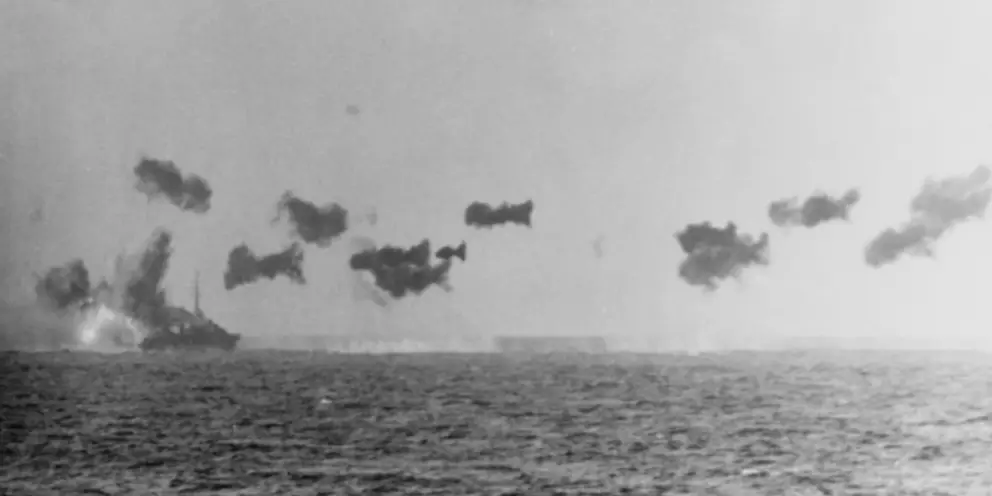
A Japanese kamikaze aircraft narrowly missed Arunta en route to support the Lingayen Gulf landings. Courtesy of Sea Power Centre.
The 1944 action began on 2 January with Arunta temporarily attached to the American Amphibious Task group 76, supporting US Army 32nd Division landings at Saidor in New Guinea, and then undertaking escort duties for the remainder of January before steaming to Sydney for refit in February. Returning to Milne Bay on 1 March, Arunta embarked US 7th Cavalry troops, stores and ammunition, and set sail for Hyane Harbour in the Admiralty Islands north of New Guinea. Arunta bombarded the shoreline, particularly focused on the approaches to Seeadler harbour on Manus Island, and then safely put the troops and stores ashore.
Although in hindsight 1944 was a busy year, with bombardment actions, enemy air attacks and encounters with enemy ships and submarines – in between, the days dragged on for the crew of Arunta. “Thoughtful and quiet, the crew relaxes, reading, dozing, talking a little, none animated, just waiting for the events of the next few days to unfold,” one sailor noted. There were long patrols in which no enemy forces were encountered, periods of refit and leave, and unopposed bombardments in which Arunta stood off to provide protection to the ships shelling the shoreline, but did not fire a round in anger themselves. One Australian sailor bemoaned the loss of interest from the public in their tedious, but still dangerous work: “In the early years of the War people were thrilled by the exploits of Allied convoys … yet … one is apt to forget, or minimise the grim war in the Pacific.”
The extraordinary had become ordinary to the public, and to many of the sailors, as Japanese power waned noticeably. Adding somewhat to the apathy at the time was the sheer scale of the US contribution to the Pacific conflict. While the Australia Squadron represented a significant portion of Australia’s naval combat power, in numbers it paled against the hundreds of ships and thousands of crew and troops brought to the fight by the Americans.
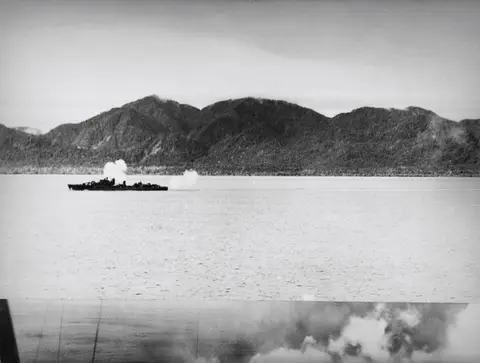
HMAS Arunta unleashes its firepower on Japanese positions at Aitape, New Guinea, July 1944.
Throughout April and May, Arunta undertook operations against Japanese-held New Guinea, returning periodically to Manus Island or Hollandia to take on stores and ammunition, undertake minor repairs and conduct training drills in preparation for further operations. Playing a key role in the now greatly enlarged Task Force 74, Arunta carried out shore bombardments throughout Hollandia and Aitape on the north coast of New Guinea.
In the initial landings of this push, 79,000 troops were put ashore with little resistance from Japanese forces, and a comparatively low level of casualties.
During the recapture of Wadke Island Arunta expended more than 300 rounds of 4.7” ammunition in one day, bombarding the adjacent mainland.
It was an astonishing feat, considering that each round weighed 50 pounds, or almost 23 kg, and the separate charge cartridge was a roughly similar weight; a bit more than 13,000 kg had to be loaded by hand, one by one into the guns in the tropical heat.
“And so the bombardment continues. B gun, then Y, until the ammunition is expended. Left and right. Up and Down like a slow symphony concert,” an Arunta gunnery sailor later wrote.
Biak
Arunta sailed from Hollandia to undertake cover operations (including an anti-submarine screen ahead of Australian and American cruisers) and bombardment operations for landings at Biak Island in Geelvink Bay, Dutch New Guinea (today’s Indonesia) on 27 May. Arunta remained in the Biak area with TG 74 and Cruiser TG 75 patrolling for Japanese counter-attack, primarily operating at night and withdrawing towards Hollandia by day to ensure enemy surface and aircraft did not scotch the landing operations. The Biak patrol ended on 10 June, with Arunta returning to Manus. This mainly uneventful period included one unsuccessful, high-speed chase of four Japanese destroyers, in which Arunta was reported to have reached a speed of 30 knots.
Patrols tended to be a mixture of lengthy periods of boredom for the crews, interspersed with brief but intense periods of fear, stress and action during shore bombardments, or attacks from enemy aircraft or ships. An astounding 545 rounds was contributed by Arunta in one unopposed bombardment of the small island of Noemfoor at the northern head of Geelvink Bay. After successfully completing these bombardments, Arunta contributed six further days of shelling targets to the larger TG74 efforts to destroy shore batteries on the New Guinea mainland east of Aitape, concluding the month when the ship was assigned to TG 78, supporting landings at Cape Sansapor.
After the successful seizure of Morotai Island (the last Allied landing campaign in New Guinea), and with General MacAurthur’s declared goal of a return to the Philippines now clearly in sight, in September Arunta and TG 74 steamed to Manus Island to make preparations for the impending Allied advance. In one week in September, 501 Japanese aircraft and 173 Japanese ships were destroyed by Allied forces, a testament to the success of Allied operations against a waning Japanese power.
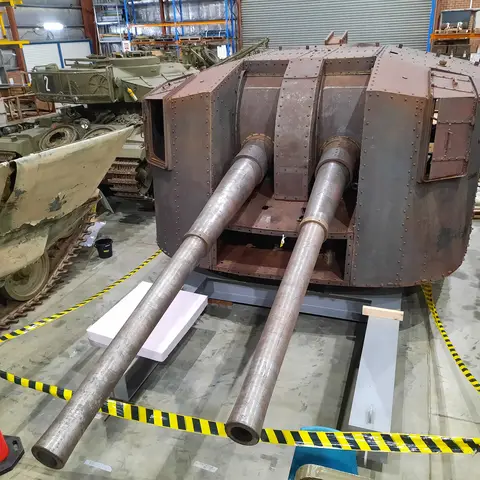
This turret was the rearmost turret mounted on HMAS Arunta, during service in the South West Pacific during the Second World War. It holds two 4.7-inch (120mm) quick-firing guns. Photo courtesy of David Pearson.
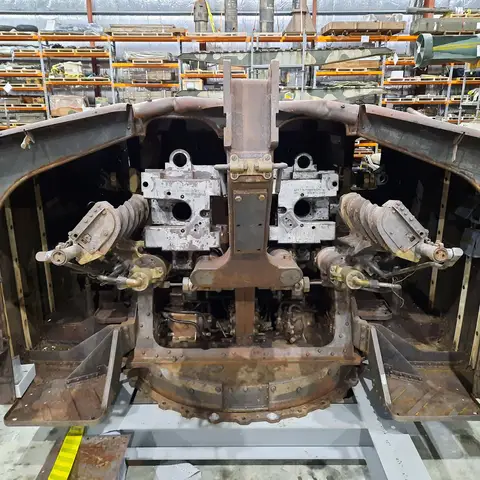
Rear view of the Arunta Y Turret showing recuperators and the internal loading and firing mechanisms. Photo courtesy of David Pearson.
Leyte Gulf
On 13 October a vast armada of US and Australian ships sailed from Hollandia towards the intended landings at Leyte Gulf in the Philippine islands. Along with HMA Ships Australia, Warramunga and Shopshire as part of the close covering group, Arunta undertook pre-landing shore bombardments – before MacArthur waded ashore on Leyte Island on 20 October and famously declared, “People of the Philippines, I have returned.” It may have been a key moment for General MacArthur, but the fleet continued with their defence of the sea lanes, which included a number of major surface and air battles in the final months of the war. Unlike earlier actions of 1944, the Leyte Gulf landings were characterised by “much noise… where battleship, cruiser, destroyer and aerial bombardments provided the heavy thunder to the continous roar of the rocket explosions on the beaches.” The doldrums of seemingly endless patrols without action were over for the crew of Arunta, at least for now.
In one of the best-known actions by the RAN, Australia was struck by kamikaze at 06.05 on 21 October in Leyte Gulf.
Accounts of the attack differ, but Commanding Officer Captain Emille Dechaineux and 29 other men were killed, and a further 64 including Commodore John Collins were wounded. Australia withdrew from the area, escorted by Warramunga, for repairs and to tend to the casualties. Arunta and the heavy cruiser Shropshire remained on station with the task group.
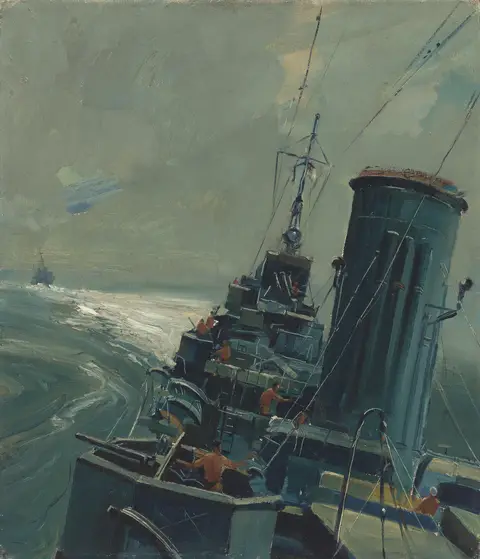
Alan Moore, HMAS Arunta patrolling the Admiralty Islands, 1944, oil on canvas on board
Living up to its motto ‘Conquer or Die’, Arunta and Shropshire fought in what was to be the final surface engagement of the Second World War: the battle of Surigao Strait, south-east of Leyte, on 25 October 1944. Earlier in the Pacific campaign, the Japanese fleet had demonstrated unexpectedly excellent and well-developed night-fighting capability in the attacks on Allied forces at Guadalcanal. Learning from this, the Allied task groups continued to adapt their technology, tactics and training and the engagement at Surigao Strait was a testament to their efforts: a successful battle accomplished in total darkness.
Two Japanese battleships and three destroyers were sunk in this battle, spelling the practical end of their fleet. As part of this action Arunta, using torpedoes under radar guidance, contributed to the destruction of the Japanese battleship Yamashiro, which sank amid an ‘unearthly silence’ that fell across Surigao Strait after the battle ended. Only two Japanese ships escaped: a destroyer, and a heavy cruiser that were sunk the following day by Allied forces. In contrast, the Allied forces lost no ships and suffered only superficial damage; one US destroyer was hit by enemy gunfire, but was able to continue to fight.
By the end of the day on 26th October, the battle of Leyte Gulf was over. Enemy forces had either been destroyed or had retreated, greatly alleviating the Japanese threat to the Allied landings in the Philippines. Much of the Japanese naval surface power was crippled or destroyed. Arunta patrolled the gulf for 28 days, suffering frequent and increasingly desperate air attacks the entire time, but was undamaged. Arunta departed for Manus on 16 November, then carried out supporting bombardments and patrols on 15 December for the landing on Mindoro island south of Luzon. The Australia Squadron, accompanied by three US destroyers, ended the incredible year that was 1944 by sailing back to Leyte on 26 December to make preparations for the impending second phase of the Philippines campaign. Throughout 1944, Arunta had fired thousands of rounds and participated in numerous landing and patrol operations, but was somehow unscathed, with no casualties or enemy damage to the ship.
Of course, the war did not end in 1944 for Arunta, despite being damaged on 5 January 1945 by a kamikaze that narrowly missed the port side. Debris hit the ship when the bomb carried by the aircraft exploded, causing substantial damage and temporary loss of steering control. It also caused the death of two sailors (Able Seaman H.L.E. Sellick, and Stoker Petty Officer R.A. Hand) and the wounding of five others from a ship’s complement of approximately 250 men. Despite the damage, along with ten other RAN ships in a combined total of 850 Allied vessels, Arunta took part in the Lingayen Gulf landing on 9 January. It remained in area for several days, departing to escort Australia (badly damaged after five kamikaze strikes in four days) to Leyte, where Arunta also undertook much needed repairs from damage suffered.
By February 1945, the positive conclusion of the Philippines campaign was in sight for the Allies, with Manila reduced, the sea approaches under Allied control, and Japanese invasion forces overcome. Arunta remained on station as part of the Lingayen Defence Force operating in the New Guinea, Philippines and general South West Pacific Area, providing bombardment and covering patrols of the Corregidor, Brunei and Balikpapan landings before returning to Sydney in July for a major refit. There the vessel remained at the end of the war on 15 August 1945. “In this drama, the main stage is the sea,” noted Vice Admiral Sir Guy CC Royle, Chief of the Naval Staff.

One of Arunta's 4.7 inch gun being loaded for transport to the Memorial. Courtesy of Sea Power Centre
The final fate of HMAS Arunta is a sad tale, hardly befitting the distinguished service of the ship and crew. Post-war the ship returned to the theatre to undertake repatriation and patrol operations. In the early 1950s Arunta was converted to an anti-submarine destroyer and carried out general naval duties, including service in Korean waters. On 21 December 1957 she was decommissioned, and sold for scrap to the China Steel Corporation in October 1968. Leaving Sydney under tow on 12 February 1969, the ship developed a list and sank off Broken Bay. It was deemed to be unsalvageable, and was left on the seafloor as a wreck.
Only one complete Tribal Class Destroyer remains today: the former flag ship of the Canadian fleet, HMCS Haida, now on public display as a National Historic Site in Hamilton, Ontario, after service in the Second World War, Korea and the Cold War. The Y turret held by the Australian War Memorial is thought to be the only remaining dismounted turret of its kind. Along with the fire control system and a set of torpedo tubes, it is one of the few physical reminders of an important contribution by an Australian-built vessel and Australian crew to wartime success in the Pacific.

